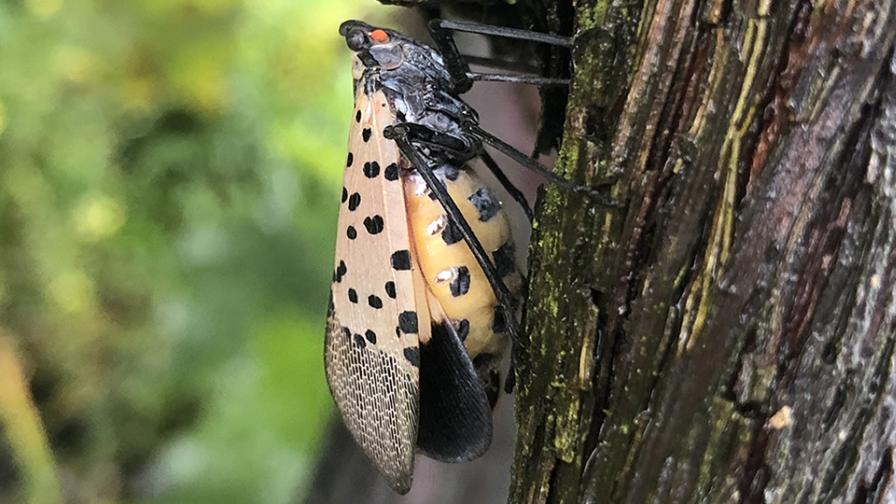DYK? Walnuts Are a Host for the California-Bound Spotted Lanternfly

Spotted lanternfly has now marched from the East Coast as far West as Indiana, and experts believe it is only a matter of time before it invades California and the state’s grapes, a favorite food. Walnut crops could serve as a potential spotted lanternfly host.
Photo by Surendra Dara
The march of the spotted lanternfly (SLF) continues seemingly inexorably across the U.S. The pest, like many invasive insects of the past few decades, is native to China, a byproduct of increased global trade. Lycorma delicatula was first detected in the U.S. in a shipment of decorative rock that arrived in Pennsylvania in 2014, and has since spread to 16 other states, from the mid-Atlantic, up into New York and New England, down the East Coast to North Carolina, and across the Midwest as far west as Indiana.
It’s only a matter of time, most experts believe, before it arrives in California. The pest, like the brown marmorated stink bug before it, is a good traveler. And like many invasive pests, it can spread across its host range in the absence of natural enemies that usually keep pests under check in their native countries, says Surendra Dara, who’s been studying the pest since it first arrived in the country.
Dara immediately became concerned because one of SLF’s favorite foods is grapes, and when it arrived in the U.S., he was serving as an Extension Farm Advisor on the Central Coast of California, a heavy wine grape region. He has since moved on to become Director of Oregon State University’s North Willamette Research and Extension Center in Aurora, OR, but continues his work on SLF in his spare time because it’s so important.
“It’s just a matter of time before it gets to the West Coast,” he says. “SLF is adapted to survive harsh winters as eggs are protected by a waxy covering, and with climate change, we’re not having the usual harsh winters that reduce a lot of the pest populations anyway. And if we don’t have them, then you know things can get worse.”
Besides, he notes that the key crops in his new home in the Pacific Northwest, such as apples, pears, cherries, and, of course, grapes, all are potential targets for SLF.
WALNUTS THREATENED
Among California’s three major nut crops — almonds, pistachios and walnuts — just walnuts are a host of SLF, Dara says. That is the key point for growers to remember, because while SLF will feed on walnuts, unlike other nuts, it’s not considered a serious threat, Dara says. That’s in part because SLF will only feed on the nuts when the pest is still immature, in the fourth instar stage or younger.
“They do feed on them, but they don’t cause significant damage to the extent that it can kill the tree, like it does in grapes,” he says.
There’s not a lot walnut or other growers can do to prepare for the pest, unless it’s to pray for biological control. Classical biological control is the best option for invasive pests for many reasons, Dara says, but as of yet, researchers don’t have any candidates. SLF has natural enemies, parasitoids, in China. They have been and will be tested, but so far researchers haven’t found any that they are certain to attack SLF — and only SLF — because upsetting the natural ecological balance could be disastrous.
“It is the host specificity that is the big concern. When we import a natural enemy from a foreign country, it has to be specific, very specific to the target pest,” he says. “The host specificity seems to be an issue. And because of that, we can’t (yet) use imported biological control agents in this case. But some native or established natural enemies are attacking various stages of SLF, providing some level of control.”
TELL YOUR FRIENDS
Controlling SLF with insecticides is not practical because though the pest is relatively easy to kill, it invades in such numbers that you would have to spray so much it’s not practical on a number of levels. When they do arrive in California, they may come in large numbers.
California is unfortunate in that it not only produces a lot of SLF’s favorite food, grapes, but is inundated by their favorite host. Tree of heaven (Ailanthus altissima) is a rapidly growing deciduous tree, also native to China, that is found throughout California.
The main thing all growers can do right now is to learn about the pest, especially being able to quickly identify it, Dara says. But the most important action growers can take is to educate the general public about the threat. One thing that can get the public’s attention is that SLF is not just a threat to agriculture. It loves roses and other landscape plants, as well as other trees.
“The reason I started talking about it in California is to spread the word to both growers and non-ag people that they can ID it and report it,” he says. “SLF infestations could get very bad, but I’m optimistic. When they come in the hundreds of thousands it can seem overwhelming, but we’ve dealt with a lot of invasive pests over the years and can tackle this one, too.”









